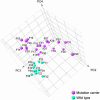A unique gene expression signature discriminates familial Alzheimer's disease mutation carriers from their wild-type siblings
- PMID: 16199521
- PMCID: PMC1253556
- DOI: 10.1073/pnas.0504178102
A unique gene expression signature discriminates familial Alzheimer's disease mutation carriers from their wild-type siblings
Abstract
Alzheimer's disease (AD) is a neurodegenerative disease with an insidious onset and progressive course that inevitably leads to death. The current diagnostic tools do not allow for diagnosis until the disease has lead to irreversible brain damage. Genetic studies of autosomal dominant early onset familial AD has identified three causative genes: amyloid precursor protein (APP), presenilin 1 and 2 (PSEN1 and PSEN2). We performed a global gene expression analysis on fibroblasts from 33 individuals (both healthy and demented mutation carriers as well as wild-type siblings) from three families segregating the APP(SWE), APP(ARC) and PSEN1 H163Y mutations, respectively. The mutations cause hereditary progressive cognitive disorder, including typical autosomal dominant AD. Our data show that the mutation carriers share a common gene expression profile significantly different from that of their wild-type siblings. The results indicate that the disease process starts several decades before the onset of cognitive decline, suggesting that presymptomatic diagnosis of AD and other progressive cognitive disorders may be feasible in the near future.
Figures




References
-
- McKhann, G., Drachman, D., Folstein, M., Katzman, R., Price, D. & Stadlan, E. M. (1984) Neurology 34, 939-944. - PubMed
-
- World Health Organization (1992) The ICD-10 Classification of Mental and Behavioural Disorders: Clinical Descriptions and Diagnostic Guidelines (WHO, Geneva).
-
- American Psychological Association (1994) Diagnostic and Statistical Manual of Mental Disorders (Am. Psychol. Assoc., Washington, DC).
-
- Selkoe, D. J. & Podlisny, M. B. (2002) Annu. Rev. Genomics Hum. Genet. 3, 67-99. - PubMed
-
- Mullan, M., Crawford, F., Axelman, K., Houlden, H., Lilius, L., Winblad, B. & Lannfelt, L. (1992) Nat. Genet. 1, 345-347. - PubMed
Publication types
MeSH terms
Substances
LinkOut - more resources
Full Text Sources
Other Literature Sources
Medical

